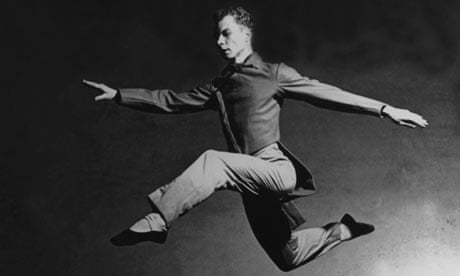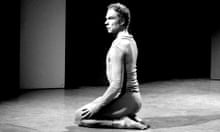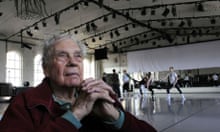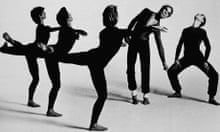Merce Cunningham, who has died aged 90, was one of the greatest choreographers of the 20th century, and the greatest American-born one. As a choreographer, he never abandoned the voyage of discovery that he embarked on at the beginning of his career. Like his life partner and frequent collaborator, the composer John Cage, he remained intransigent to the last. He continued to lead his dance company, founded in 1953, until his death, and presented a new work, Nearly Ninety, last April, at the Brooklyn Academy of Music, New York, to mark his 90th birthday.
In spite of what was often seen as his iconoclasm, his work was essentially classical in its formal qualities, its rigour, and its purity. Both Cunningham and Cage used chance processes, though in very different ways: Cage carried them through to the actual performance of his music, while Cunningham used them only in the creation of the choreography itself. As with any other compositional tool, what really matters is the quality of the imagination at work. Apart from Cunningham's sheer fecundity of invention, his choreography was notable for its strength of structure, even though that structure was organic rather than preconceived.
Merce never gave the impression that he was concerned with what happened to his work after he was gone. He was, like most creative artists, chiefly involved in the work he was doing now – or was going to do next. His interest in new technology was well known. His pioneering work in film and video, which began in the early 1970s, first with Charles Atlas and later with Elliot Caplan, proposed a grammar of dance on camera. In the 90s, his fascination with the computer program DanceForms led to the formulation of a new choreographic complexity.
The most controversial of the innovations that he and Cage introduced was undoubtedly the separation of dance from music, prompted by their belief that the most important thing the two arts have in common is that they exist in time. It is possible that Cunningham would have achieved greater popularity if he had choreographed to recognisable music instead of the "live electronic music" composed by Cage, David Tudor, Takehisa Kosugi, and other musicians who worked with him. But of course his work would have been very different if he had.
Having worked with Merce since 1959 – first as a studio administrator, then, from 1976, as company archivist – I have had an unparalleled opportunity to observe his career from close up. I first met him in October 1950, when I left Britain to go to New York to study at George Balanchine's School of American Ballet, the associate school of the New York City Ballet. At that time, Cunningham was teaching a class in modern dance there once a week.
At the time, Lincoln Kirstein, the school's general director, was not as dismissive of modern dance as he later became: in 1947 he commissioned a ballet from Cunningham and Cage, The Seasons, with decor by Isamu Noguchi, for the second season of Ballet Society, forerunner of New York City Ballet. This was the first of what came to be known as Cunningham's "chance ballets", Sixteen Dances for Soloist and Company of Three (1951). Cage played for Cunningham's class at the American school; he knew at most three tunes, among them Three Blind Mice.
Merce and John went off on tour after a few weeks, and never came back to the school. In the summer of 1953, at Black Mountain College, he founded the Merce Cunningham Dance Company (which included the young Paul Taylor, who had been in the Graham company with him). Sixteen Dances for Soloist and Company of Three – the first collaboration by Cage and Cunningham that I saw – was performed as part of a season of American dance at the Alvin Theatre, New York, sandwiched between works by Martha Graham and José Limón, whose supporters were united, if in nothing else, by their detestation of everything Merce and John did and stood for. The evening was not perhaps in the same league as the premiere of The Rite of Spring in 1913, but it was more of a scandal than often occurred in New York at the time. The choreographer Anna Sokolow hit the man sitting behind her to make him shut up.
The performance was striking for its wit and brilliant inventiveness, and from that time I never missed a Cunningham performance if I could help it. As it happened, I found myself in a uniquely favourable position not to do so: a few years later, I began to study with Cunningham again. In December 1959 Cunningham opened a studio in New York, on the top floor of a building on the corner of 14th Street and 6th Avenue occupied by the Living Theatre, and he invited me to come and work for him.
In June 1964 the company embarked on a tour that lasted six months and took us round the world. By the end, many things had changed. The artist Robert Rauschenberg was no longer its resident designer and technical director, having won the grand prize at the Venice Biennale and become world famous.
But Cunningham too had gained a kind of recognition that he had not received at home. In Paris and particularly in London, where a week's engagement at Sadler's Wells had been extended by the producer Michael White by a further two-and-a-half weeks at the Phoenix, the work of Cunningham and his collaborators was taken seriously by such critics as Dinah Maggie of the French newspaper Combat and, in London, by Alexander Bland, Richard Buckle, Wilfrid Mellers and John Percival, and by audiences that included artists and, especially, theatre people. Directors like George Devine, Lindsay Anderson, William Gaskill and Peter Brook, the designer Jocelyn Herbert and actors like Irene Worth and Harold Lang came night after night.
Word of this response found its way back to the United States, and the company returned to find there a new curiosity about its work. Not long afterwards, the National Endowment for the Arts and the New York State Council on the Arts were formed. Both sponsored touring programmes with residencies and performances, and Cunningham's company was among the first to be included. As the dance writer Nancy Dalva observed, it was not that Cunningham had gone establishment, but that the establishment had gone Cunningham.
In France, thanks to the advocacy of the late Michel Guy, director of the Paris Autumn festival and sometime minister of culture, and of Bénédicte Pesle, Cunningham's European representative, his work found even greater acceptance than at home.
Cunningham (his original given names were Mercier Philip) was born in Centralia, a small town in the state of Washington in the north-west United States. His father, Clifford D Cunningham of Irish descent, was a lawyer and his mother, Mayme, was from a family whose origin was Slavic. Neither parent had any connection with the theatre, though Cunningham once said that his father had a certain histrionic talent in the courtroom. Cunningham was the second of their three sons; both his brothers followed their father into the legal profession. (Cunningham, being questioned once on jury duty, said: "I'm the criminal in the family.")
As a teenager, Cunningham studied tap and ballroom dance with a local teacher, Mrs Maude Barrett, who had a great influence on him. He began to perform in her school recitals, and even went with her on what he described as "a short and intoxicating vaudeville tour" as far as California in the year before he graduated from high school, an experience that turned him into a trouper, which he remained throughout his career. After graduating, he went to George Washington University in Washington DC, but quit after a year and enrolled at the Cornish School in Seattle, originally with the intention of studying acting. But he soon changed his field of studies to dance. He also spent a summer at the Bennington School of Dance in Oakland, California.
Cunningham first met Cage in 1938 when Bonnie Bird, the dance instructor at Cornish, engaged him as the accompanist for her dance classes. A year later Cunningham left to join Martha Graham's company in New York, where he remained until 1945 taking leading roles as a soloist in El Penitente (1945), Letter to the World (1940), and Appalachian Spring (1944). Cage made his way to New York in 1942, and wrote the score for Credo in Us, jointly choreographed by Cunningham and Jean Erdman, and Totem Ancestor, which was a solo in Merce's first independent dance recital. Thus began a collaboration that was to last until Cage's death in August 1992.
Neither of them talked openly about the nature of their personal, as opposed to professional, relationship. When a young man who no doubt hoped to "out" them once asked in a public forum about their domestic life, John said, after a pause, "Well, I do the cooking … and Merce does the dishes."
Anyone who knew Merce in the earlier years of struggle was familiar with those times when he would descend into a mood of black despair and anger (I often wondered how Cage dealt with those moods). The astonishing thing was that these did not recur when his dancing days were more or less over. Cunningham seemed to find ample satisfaction in creating choreography for the young dancers of his company that pushed them to ever greater heights of virtuosity. But he never wanted to stop performing – he was one of those performers who are most alive on stage. This remained true even in later years when, as he put it, he "appeared" rather than danced – every step caused him pain, but he still made himself walk out for his curtain call from the farthest upstage wing.
Judith Mackrell writes: It was only last month that Merce Cunningham and his company were announcing plans about how to safeguard the choreographer's work after his death. As Cunningham said to journalists at the time: "It's really a concern about how you preserve the elements of an art which is really evanescent, which is really like water."
It was obviously a prudent action to take, given that Cunningham had turned 90 this April. But it also seemed so abstract. Despite his age, despite being confined to a wheelchair, Cunningham had shown no signs of giving up his work ("choreography is like knitting," he once told me, "I don't stop"). In his own inimitable and mild-mannered way, he had seemed immortal.
Cunningham's genius was not the storm-und-drang kind – he wasn't the type of man to take up all the oxygen. While his first employment was possibly the best job going in modern dance – it led to him performing with the great pioneer Martha Graham – he only stayed in it for six years, driven by an almost boffin-like curiosity to explore his own ideas.
During the late 1940s, Cunningham worked on developing his own choreographic language, based on a fusion of modern and classical dance, but also on his observations of how ordinary people and animals moved. It constantly delighted him to see how different steps and gestures could be put together – in one phrase a dancer might be executing a slow circle of a leg, while her bent arms rotated like propellers and her head turned this way and that like an anxious bird.
No one else made dance that looked remotely like this, and at the same time no one else had Cunningham's conceptual ambitions. It was at this time that he came under the influence of his long-term partner and artistic collaborator John Cage, and became fascinated by Cage's use of chance principles in composition – often throwing dice or using techniques such as the I Ching to determine the sequence of movements or the number of dancers he might use. Cunningham also developed his now-famous method of creating choreography independently of his music and design, seeing what would happen when the three elements came together at a late rehearsal, or even at a first performance.
This was not some hippyish abnegation of control; rather he was using chance as a way of going beyond the limits of his own mind and imagination. The human body offered a constantly intriguing set of possibilities for Cunningham. And it was for this reason that he had no interest in telling stories or inventing characters with dance – there were already too many shapes, patterns and rhythms to discover and explore.
Throughout his career he continued to make those explorations. It was Cunningham who led the way in using computers as an aid to creating dances; he was later one of the first choreographers to use digital technology in staging his work. There was always a part of the dance world, which regarded Cunningham as too cerebral, too weird, that resisted these preoccupations. Some of his early reviews were terrible. Yet for those of us who have loved and admired his works, they seemed the opposite of dry. For one thing Cunningham was a rare, instinctive showman. On stage he was mesmerizing.
Even in his 90s, when he was ravaged by arthritis, his dancing contained a burnished intelligence. And the choreography he created was just as compelling, just as rich. Some of his works were very funny; some inexplicably moving. Watching a Cunningham dance could be as absorbing and overwhelming as observing a landscape, a starlit sky or a city crowd.
There was nothing godlike about Cunningham's ego, but something godlike in the works he created.






